Polycystic ovary syndrome
Polycystic ovary syndrome (PCOS) is a condition in which a woman has increased levels of male hormones (androgens). Many problems occur as a result of this increase of hormones, including:
- Menstrual irregularities
- Infertility
- Skin problems, such as acne and increased hair growth
- Increased number of small cysts in the ovaries
- Insulin resistance, with an increased risk of developing diabetes
Causes
PCOS is linked to changes in hormone levels that make it harder for the ovaries to release fully-grown (mature) eggs. The reasons for these changes are unclear. The hormones affected are:
- Estrogen and progesterone, the female hormones that help a woman's ovaries release eggs
- Androgen, a male hormone that is found in small amounts in women
Normally, one or more eggs are released during a woman's cycle. This is known as ovulation. In most cases, this release of eggs occurs about 2 weeks after the start of a menstrual period.
In many women with PCOS, mature eggs are not released. Instead, they stay in the ovaries with a small amount of fluid (cyst) around them. The affected ovary may be slightly enlarged. There can be many of these. However, not all women with the condition will have ovaries with this appearance.
Women with PCOS have cycles where ovulation does not occur every month which may contribute to infertility The other symptoms of this disorder are due to the high levels of male hormones.
Infertility
Infertility means you cannot get pregnant (conceive). There are 2 types of infertility:Primary infertility refers to couples who have not become preg...

Most of the time, PCOS is diagnosed in women in their 20s or 30s. However, it may also affect teenage girls. The symptoms often begin when a girl's periods start. Women with this disorder often have a mother or sister who has similar symptoms.
Symptoms
Symptoms of PCOS include changes in the menstrual cycle, such as:
- Not getting a period after you have had one or more normal ones during puberty (secondary amenorrhea)
Secondary amenorrhea
Absence of a woman's monthly menstrual period is called amenorrhea. Secondary amenorrhea is when a woman who has been having normal menstrual cycles...
 ImageRead Article Now Book Mark Article
ImageRead Article Now Book Mark Article - Irregular periods that may come and go, and be very light to very heavy
Other symptoms of PCOS include:
- Extra body hair that grows on the chest, belly, face, and around the nipples
- Acne on the face, chest, or back
- Skin changes, such as dark or thick skin markings and creases around the armpits, groin, neck, and breasts
The development of male characteristics is not typical of PCOS and may indicate another problem. The following changes may indicate another problem apart from PCOS:
- Thinning hair on the head at the temples, called male pattern baldness
- Enlargement of the clitoris
- Deepening of the voice
- Decrease in breast size
Exams and Tests
Your health care provider will perform a physical exam. This will include a pelvic exam. The exam may show:
- Enlarged ovaries with many small cysts noted on ultrasound
- Enlarged clitoris (very rare)
The following health conditions are common in women with PCOS:
-
Insulin resistance and diabetes
Diabetes
Diabetes is a long-term (chronic) disease in which the body cannot regulate the amount of sugar in the blood.
 ImageRead Article Now Book Mark Article
ImageRead Article Now Book Mark Article - High blood pressure
- High cholesterol
- Weight gain and obesity
Your provider will check your weight and body mass index (BMI) and measure your belly size.
Blood tests can be done to check hormone levels. These tests may include:
- Estrogen level
- FSH level
FSH level
The follicle stimulating hormone (FSH) blood test measures the level of FSH in blood. FSH is a hormone released by the pituitary gland, located on t...
Read Article Now Book Mark Article - LH level
LH level
The LH blood test measures the amount of luteinizing hormone (LH) in blood. LH is a hormone released by the pituitary gland, located on the undersid...
Read Article Now Book Mark Article - Male hormone (testosterone) level
Testosterone
A testosterone test measures the amount of the male hormone, testosterone, in the blood. Both men and women produce this hormone. The test described...
 ImageRead Article Now Book Mark Article
ImageRead Article Now Book Mark Article - Progesterone level
Other blood tests that may be done include:
- Fasting glucose (blood sugar) and other tests for glucose intolerance and insulin resistance
Fasting glucose
A blood sugar test measures the amount of sugar (glucose) in a sample of your blood. Glucose is a major source of energy for most cells of the body, ...
 ImageRead Article Now Book Mark Article
ImageRead Article Now Book Mark Article - Lipid level
- Pregnancy test (serum hCG)
Pregnancy test
A pregnancy test measures a hormone in the body called human chorionic gonadotropin (HCG or hCG). HCG is a hormone produced during pregnancy. It ap...
 ImageRead Article Now Book Mark Article
ImageRead Article Now Book Mark Article - Prolactin level
Prolactin level
Prolactin is a hormone released by the pituitary gland. The prolactin blood test measures the amount of prolactin in the blood.
 ImageRead Article Now Book Mark Article
ImageRead Article Now Book Mark Article - Thyroid function tests
Thyroid function tests
Thyroid function tests are used to check whether your thyroid is working normally. The most common thyroid function tests are:Free T4 (free thyroxine...
 ImageRead Article Now Book Mark Article
ImageRead Article Now Book Mark Article
Your provider may also perform or order an ultrasound of your pelvis to look at your ovaries.
Treatment
Weight gain and obesity are common in women with PCOS. Losing even a small amount of weight can help treat:
- Hormone changes
- Conditions such as diabetes, high blood pressure, or high cholesterol
Your provider may prescribe birth control pills to make your periods more regular. These pills may also help reduce abnormal hair growth and acne if you take them for several months. Long acting methods of contraception hormones, such as hormone releasing intrauterine devices (IUDs), may help to stop irregular periods and the abnormal growth of the uterine lining.
A diabetes medicine called metformin (Glucophage) may also be prescribed to:
- Make your periods regular
- Prevent type 2 diabetes
- Help you lose weight
Other medicines that may be prescribed to help make your periods regular and help you get pregnant are:
- LH-releasing hormone (LHRH) analogs
- Clomiphene citrate or letrozole, which may allow your ovaries to release eggs and improve your chance of pregnancy
These medicines work better if your body mass index (BMI) is 30 kilograms per square meter or less (below the obese range).
Your provider may also suggest other treatments for abnormal hair growth. Some are:
- Spironolactone or flutamide pills
- Eflornithine cream
Effective methods of hair removal include electrolysis and laser hair removal. However, many treatments may be needed. Treatments are expensive and the results are often not permanent.
A pelvic laparoscopy may be done to remove or alter an ovary to treat infertility. This improves the chances of releasing an egg. The effects are temporary.
Pelvic laparoscopy
Pelvic laparoscopy is surgery to examine the pelvic organs. It uses a viewing tool called a laparoscope. The surgery is also used to treat certain ...

Outlook (Prognosis)
With treatment, women with PCOS are very often able to get pregnant. During pregnancy, there is an increased risk of:
- Miscarriage
- High blood pressure
- Gestational diabetes
Possible Complications
Women with PCOS are more likely to develop:
- Endometrial cancer
- Infertility
- Diabetes
- Obesity-related complications
When to Contact a Medical Professional
Contact your provider if you have symptoms of this disorder.
Reviewed By
LaQuita Martinez, MD, Department of Obstetrics and Gynecology, Emory Johns Creek Hospital, Alpharetta, GA. Also reviewed by David C. Dugdale, MD, Medical Director, Brenda Conaway, Editorial Director, and the A.D.A.M. Editorial team.
Bulun SE. Physiology and pathology of the female reproductive axis. In: Melmed S, Auchus RJ, Goldfine AB, Koenig RJ, Rosen CJ, eds. Williams Textbook of Endocrinology. 14th ed. Philadelphia, PA: Elsevier; 2020:chap 17.
Catherino WH. Reproductive endocrinology and infertility. In: Goldman L, Cooney KA, eds. Goldman-Cecil Medicine. 27th ed. Philadelphia, PA: Elsevier; 2024:chap 218.
Lobo RA. Polycystic ovary syndrome. In: Gershenson DM, Lentz GM, Valea FA, Lobo RA, eds. Comprehensive Gynecology. 8th ed. Philadelphia, PA: Elsevier; 2022:chap 39.
Zi-Jiang C, Legro RS, Ehrmann DA, Wei D. Androgen excess disorders in women. In: Robertson RP, ed. DeGroot's Endocrinology. 8th ed. Philadelphia, PA: Elsevier; 2023:chap 124.
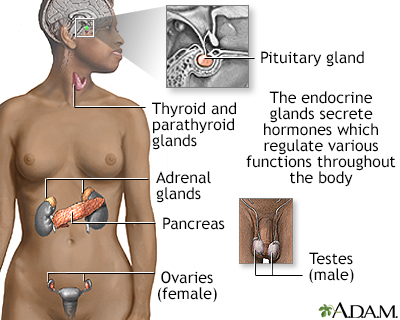
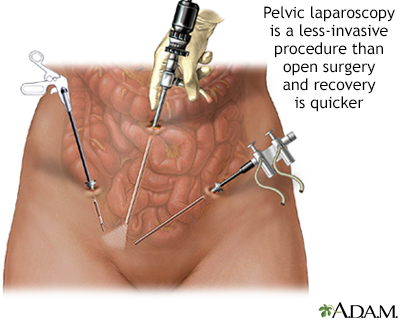
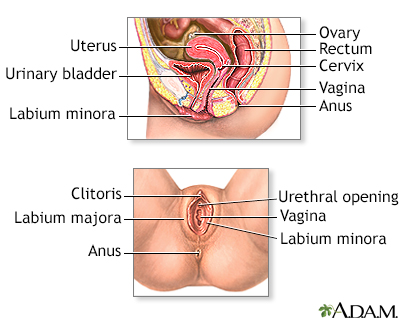
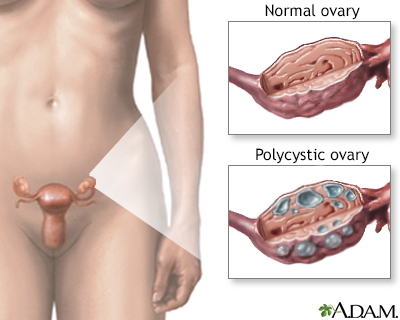
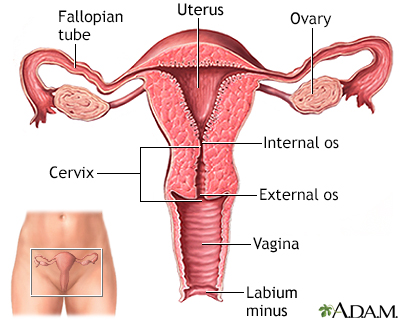

 All rights reserved.
All rights reserved.